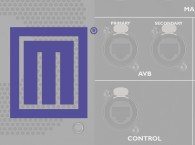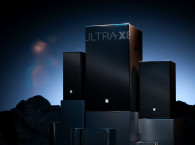
"Complex and visually-focused production scenarios, coupled with tighter safety regulations, often restrict the space and weight allowed for loudspeakers. At the same time, environmental policies require greater energy efficiency and a smaller footprint for transport as more productions shift to a networked signal infrastructure." This was the core briefing that motivated Meyer Sound to create the new Phantom line array element. Responding to these demands, Panther’s acoustic output is closer to the significantly larger and heavier LEO line array loudspeaker and occupies the slender form factor of the existing LYON line array loudspeaker.
Designed to fit stadium levels of performance, the new Panther weighs just 150lb (68Kg) - impressive considering the fact that it is an active system, fitted with a new generation Class-D amplifier with a more efficient power supply (GaN?) that Meyer Sound says offers substantial savings on current draw from the previous generation flagship line array loudspeaker. The new electronics module is a four-channel design with advanced power factor correction and higher voltage rails, delivering higher peak current to the loudspeakers while presenting a stable load to the AC line.

Connectivity includes analog XLR inputs and an Ethernet network connector that is ready (and certified) to work with the Milan AVB protocol, currently under-development. The input module uses Meyer Sound’s new Avnu Alliance-certified Milan input module, effectively making Panther the world’s first Milan Certified line array loudspeaker. This will allow Panther systems to work fully networked and controlled by Meyer Sound's digital network processors, interfaces and software. No information is provided if the Ethernet connector will also support any of the industry-standard audio network protocols, such as Dante or Ravenna.
“This is our most significant loudspeaker introduction in more than a decade,” says John Meyer, President & CEO of Meyer Sound. “Panther advances my commitment to making loudspeakers with linear response, predictable coverage, and extended headroom for dynamic, uncompressed music reproduction — transient peaks in particular. Essentially, Panther produces nearly the same power and headroom as LEO in the footprint of LYON. I’m proud of how our engineers achieved ambitious performance benchmarks while reducing weight and increasing energy efficiency.”
Each Panther element features new, longer-excursion 12-inch low-frequency cone drivers and new 3-inch compression drivers. Each said to incorporate "advanced magnet structures using new materials for higher flux density despite substantial weight reduction." The key to the new "compact but powerful" design resulted from a new LF port - a new 80-degree “L” horn that is able to fit in a much more compact cabinet.
According to Bob McCarthy, Meyer Sound Director of System Optimization, "The Panther-L horn is an extraordinary piece of engineering, but that’s not surprising as Meyer Sound has always excelled in horn design. The beauty of it to me is the way it holds a large majority of its angular coverage inside a 3dB window, then dips out quickly with a well-defined edge at 80 degrees. That gives us a clear place to join with other arrays or fill systems, so we can maintain consistent response across all frequencies."

And this new new design makes Panther a significantly lighter line array element than anything in its class, while being able to generate a maximum peak output of more than 150dB SPL. Never compromising John Meyer’s performance goals, the Panther engineering team, led by Engineering Director, Acoustical & Mechanical, Katie Murphy, pursued a unified approach to weight reduction.
“With Panther, we excelled with a full system design approach,” says Murphy. “We had the electrical and mechanical engineers working in a coordinated effort, which meant we could leverage reduced amplifier and transducer weight with new cabinet designs and materials to further reduce weight. Everybody was in sync at every step to achieve our goals.”
Reduced weight means more Panther loudspeakers can be flown on a single motor, and larger arrays can share the same truss and hang points with extensive video and lighting gear. Also, larger and longer arrays can be flown outdoors while complying with new safety regulations related to wind events. Shipping costs will be substantially reduced, particularly when air transport is required. Panther’s significant weight and size reduction also contributes to less CO2 emissions during transportation.
The Panther family consists of three cabinets with different horizontal coverage patterns. The all-new Panther-L features a long-throw horn with the tightly defined 80-degree horizontal pattern. Complementing the Panther-L, the Panther-M and Panther-W are 95 and 110 degrees, respectively, and will be familiar options for existing Meyer Sound owners. These three options allow system designers to precisely tailor coverage in any size venue with uniform response from front to back and enable deployment of fewer arrays or shorter arrays in some applications, such as in-the-round configurations.
And each cabinet comes standard with weather protection — all at a substantially lower initial cost compared to LEO and LYON systems. Every Panther element is weather protected to the new IEC IP55 standard with full rain protection when using mating Neutrik TOP series signal and powerCON connectors. No rain hood is required. With standard weather protection, the same Panther cabinets can be used for indoor or outdoor events with no special preparations required.

With the compact size and lower weight, the same Panther inventory can be assigned to a wide range of applications, from theaters and convention halls up to arenas, stadiums, and festival sites. Meyer Sound’s continual investment in materials and design standards means also that the price is substantially lower than the previous generation and below the most direct competitor models when factoring in comparable amplification and processing.
“Everybody on the team really came together and put their hearts and souls into this project,” comments Katie Murphy. “We went all out to create a loudspeaker that would define line array technology for years to come.”
“We see Panther as more than just a new product, but as something that adds a new dimension to what we are doing as a company,” adds John Meyer. “It has the potential to change the path we are on in the sound industry. I’m excited to see how industry professionals — and, more importantly, audiences — respond to it.”
The Panther linear line array loudspeaker will go into production and ship in February 2022.
www.meyersound.com







